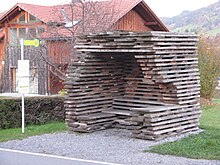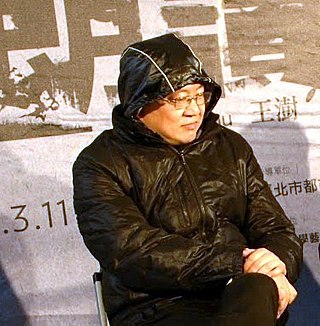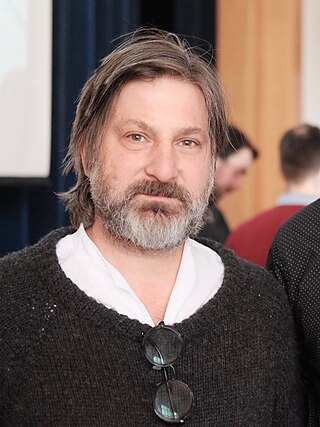
The BUS:STOP Krumbach is a construction project of seven bus stops in Krumbach in the Bregenz Forest in Vorarlberg (Austria).

The BUS:STOP Krumbach is a construction project of seven bus stops in Krumbach in the Bregenz Forest in Vorarlberg (Austria).
When it was decided in 2010 that the bus stops in Krumbach needed to be rebuilt, the director of the Architekturzentrum Wien, Dietmar Steiner, was commissioned to select seven international architects to design unusual bus stops. These were then manufactured and installed by local architects, local craftsmen and the community of Krumbach.. [1]

The BUS:STOP Krumbach project has won several awards including the Austrian State Prize for Architecture, the Austrian State Prize for Communication and Public Relations, [2] the Adwin 2015, the Icon of the International Iconic Award and the Innovation Award as "Architects' Client of the Year 2014" and the 2014 award by Vorarlberg Tourismus. [3]
| Number | Object | Architect | Partner architect | Statics | Craftsmen | Main sponsor | Description |
|---|---|---|---|---|---|---|---|
| 1 | Bus stop Krumbach-Zwing | Smiljan Radic (Chile) | Bernardo Bader | Mader Flatz (Bregenz) | Felder Metall (Andelsbuch), Holzwerkstatt Markus Faißt (Hittisau), Oberhauser & Schedler Bau (Andelsbuch), Spenglerei Manfred Baldauf (Doren) | Morscher Bau (Mellau) | The inspiration for this design was drawn from traditional Bregenz Forest artisanry. The bus stop is a reference to the Bregenz Forest farmhouse timbering. At the bus stop, a piece of the room is cut out and set into the landscape. The bus shelter is a glass pavilion with a black concrete-coffered ceiling. There are two wooden chairs in peasant style as seating. Above the glass cube, a bird house is indicated which serves as attention and distraction. |
| 2 | Bus stop Unterkrumbach Nord | Ensamble Studio, Antón García-Abril/Débora Mesa (Spain) | Dietrich/Untertrifaller Architekten | Mader Flatz (Bregenz) | Zimmerei Gerhard Berchtold (Schwarzenberg) | Hypo Vorarlberg | For this bus stop, raw and untreated oak boards were stacked. The layering of the planks creates the effect that the space is both open and closed. |
| 3 | Bus stop Unterkrumbach Süd | Architecten De Vylder Vinck Taillieu (Belgium) | Thomas Mennel (MeMux Schwarzenberg) | gbd (Dornbirn) | Waldmetall Dietmar Bechter (Hittisau), Haller Bau (Sulzberg), Malerei Raid (Krumbach) | EHG Stahl Metall (Dornbirn) | The bus stop was created by the impression of automobile coping of alpine passes. According to the architects, the triangular-shaped metal construction represents the poetic act of folding triangular surfaces. |
| 4 | Bus stop Krumbach-Glatzegg | Wang Shu/Lu Wenyu – Amateur Architecture Studio (China) | Hermann Kaufmann (Schwarzach) | Merz Kley Partner (Dornbirn) | Kaufmann Zimmerei (Reuthe), Haller Bau (Sulzberg), Spenglerei Manfred Baldauf (Doren) | Sutterlüty (Egg) | The architects were interested in a clear view in both directions. For this reason, the effect of a "Camera obscura" – a conical space – was planned. They wanted to achieve a focused perception of the surrounding landscape rather than of the object itself. |
| 5 | Bus stop Krumbach-Kressbad | Rintala Eggertsson Architects (Norway) | Baumschlager Hutter Partners | Mader Flatz (Bregenz) | Tischlerei Steurer mit Krumbacher Handwerkern, Schindeln Peter Lässer (Lingenau), Malerei Raid (Krumbach), Musikverein Krumbach, Offroader Krumbach | I+R Schertler Bau (Lauterach) | The bus stop is located at a tennis court. This allowed the team of architects to add an additional social offer to the bus shelter: a small stand for the tennis court. It was functionally designed as a wooden construction and clad with shingles. The architects' aspiration was to combine 'demand' and 'potential'. |
| 6 | Bus stop Oberkrumbach | Alexander Brodsky (Russia) | Hugo Dworzak (Architekturwerkstatt Lustenau) | Merz Kley Partner (Dornbirn) | Zimmerei Gerhard Bilgeri (Riefensberg), Spenglerei Manfred Baldauf (Doren), Oberhauser & Schedler Bau (Andelsbuch), Malerei Raid (Krumbach), Raum in Form Raimund Fink (Krumbach) | Rhomberg Gruppe (Bregenz) | The bus stop is located on a plot shared with a family home. On account of the limited space, the architect erected a radically simple wooden tower. It is open on all sides, with three sides of it glazed. At the level of the first floor, there are small window-like gaps without glazing. |
| 7 | Bus stop Krumbach-Bränden | Sou Fujimoto (Japan) | Bechter Zaffignani Architekten (Bregenz) | gbd (Dornbirn) | Eberle Metall Exclusiv (Hittisau), Malerei Raid (Krumbach), Zimmerei Gerhard Berchtold (Schwarzenberg), Haller Bau (Sulzberg) | Illwerke/VKW-Gruppe (Bregenz) | The architect Sou Fujimoto seeks to unite nature and architecture. The bus stop is designed to promote the dialogue with nature and not to provide protection from it. The "space frame" should serve as a possibility for interaction. The bus stop consists of white painted thin steel bars. Within this open sculpture, a staircase winds upwards. It should enable a new dimension of perception of place, space and nature. |

Liechtenstein, officially the Principality of Liechtenstein, is a German-speaking and doubly landlocked country and microstate located in the Alps between Austria and Switzerland. It is the sixth smallest nation worldwide. Liechtenstein is a semi-constitutional monarchy headed by the prince of Liechtenstein.

Vorarlberg is the westernmost state of Austria. It has the second-smallest geographical area after Vienna and, although it also has the second-smallest population, it is the state with the second-highest population density. It borders three countries: Germany, Switzerland, and Liechtenstein. The only Austrian state that shares a border with Vorarlberg is Tyrol, to the east.

Dornbirn is a city in the westernmost Austrian state of Vorarlberg. It is the administrative centre for the district of Dornbirn, which also includes the town of Hohenems, and the market town Lustenau.

The Bregenzerwald is one of the main regions in the state of Vorarlberg (Austria). It overlaps, but is not coterminous with, the Bregenz Forest Mountains, which belong to a range of the Northern Limestone Alps, specifically the northern flysch zone. It is the drainage basin of the Bregenzer Ach river.

Au is a town in the Bregenz Forest in Vorarlberg (Austria).

Lech am Arlberg is a mountain village and an exclusive ski resort in the Bludenz district in the westernmost Austrian state of Vorarlberg, on the banks of the river Lech.

Feldkirch is a medieval town in the western Austrian state of Vorarlberg, bordering on Switzerland and Liechtenstein. It is the administrative centre of the Feldkirch district. After Dornbirn, it is the second most populous town in Vorarlberg. The westernmost point in Austria lies in Feldkirch on the river Rhine, at the tripoint between Austria, Switzerland, and Liechtenstein.

Seefeld in Tirol is an old farming village, now a major tourist resort, in Innsbruck-Land District in the Austrian state of Tyrol with a local population of 3,312. The village is located about 17 km (11 mi) northwest of Innsbruck on a plateau between the Wetterstein mountains and the Karwendel on a historic road from Mittenwald to Innsbruck that has been important since the Middle Ages. It was first mentioned in 1022 and since the 14th century has been a pilgrimage site, benefiting not only from the visit of numerous pilgrims but also from its stacking rights as a trading station between Augsburg and the Venice. Also since the 14th century, Tyrolean shale oil has been extracted in the area. Seefeld was a popular holiday resort even before 1900 and, since the 1930s, has been a well known winter sports centres and amongst the most popular tourist resorts in Austria. The municipality, which has been the venue for several Winter Olympics Games, is the home village of Anton Seelos, the inventor of the parallel turn.

Krumbach is a village in the westernmost Austrian state of Vorarlberg, in the Bregenz district. The municipality has about 1,000 inhabitants.

The Vorarlberg University of Applied Sciences in Dornbirn in Vorarlberg (Austria) is a leading Austrian University of Applied Sciences. It was founded in 1989 going under the name of "Technical School, Vorarlberg".

Doren is a municipality in the district of Bregenz in the western Austrian state of Vorarlberg.

Langenegg is a municipality with approx. 1,200 inhabitants in the westernmost Austrian state, Vorarlberg.

Lingenau is a municipality in the district of Bregenz, in the westernmost Austrian state of Vorarlberg.

Alexander Savvich Brodsky (1955) is a Russian architect and sculptor. He is one of Russia's best known architects, particularly for his works of paper architecture.

The Kunsthaus Bregenz (KUB) presents temporary exhibitions of international contemporary art in Bregenz, Vorarlberg (Austria).

Wang Shu is a Chinese architect based in Hangzhou, Zhejiang Province. He is the dean of the School of Architecture of the China Academy of Art. With his practice partner and wife Lu Wenyu, he founded the firm Amateur Architecture Studio. In 2012, Wang became the first Chinese citizen to win the Pritzker Prize, the world's top prize in architecture. The award was the subject of some controversy since the Pritzker committee did not also award Lu Wenyu, his wife and architectural partner, despite their years of collaboration.

Sou Fujimoto is a Japanese architect.

Smiljan Radic is an internationally recognised Chilean architect of Croatian heritage. Radic graduated in 1989 in architecture at the Catholic University of Chile and established his own office in 1995. Many of his projects are small scale, such as dwellings and installation designs that bridge across various cultural traditions. Radic was selected to design the 2014 Serpentine Gallery Pavilion in London.
Jörg Streli was an Austrian architect and academic teacher at the Innsbruck University. With two colleagues, as the firm Heinz & Mathoi & Streli, he built private homes in the alpine landscape of Tyrol, schools, offices and public buildings, among others. He was also president of the architecture section of the Ingenieur- und Architektenkammer für Tirol und Vorarlberg.
Dieter Mathoi was an Austrian architect. With two colleagues, as the firm Heinz & Mathoi & Streli in Innsbruck, he worked for 35 years, building private homes in the alpine landscape of Tyrol, schools, offices and public buildings, among others. He opened his own office in 2008 and was known for prison buildings and for designing the controversial Kaufhaus Tyrol in Innsbruck with David Chipperfield.